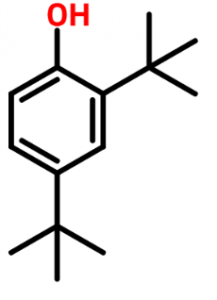
A Detailed Brief About Natural Sources and Bioactivities of 2 4-Di -Tert-Butylphenol
2 4-Di -Tert-Butylphenol is produced by various organisms belonging to various groups. 2 4-Di -Tert-Butylphenol is a toxic and secondary metabolite. When it comes to 2 4-Di -Tert-Butylphenol, the bioactivities and BioSource have been investigated, which is remarkable. On the other hand, the phenol has yet not been investigated or systematically reviewed. In this article, we will discuss the review of 96-76-4-Tert-Butylphenol and its analogues. Emphasis will also be given to natural sources and bioactivities.
2 4-Di -Tert-Butylphenol has been found in more than 169 species of bacteria, diatom, fungi, pteridophyte, liverwort, dicots and many more. The 2 4-Di -Tert-Butylphenol is a component of essential oils, and it has been found that this compound is toxic to all testing organisms. This even includes the producers. However, it has not been found why organisms produce autotoxin 2 4-DTBP along with its analogues. The evidence hence derived states that the endocidal regulations are the primary function of phenol in making organisms.
The review of bioactivities and biosources of 2,4-bis and its analogue show that the endocidal regulation is the primary function of the toxic phenols present in the produced organisms.
Antioxidant activities:
Investigation on the antioxidant activities of lipophilic phenols was made to focus on 2, 4-DTBP. Vitro methods for assaying the antioxidant activities are being used, such as low-density lipoprotein, which includes thiobarbituric acid substances that are highly reactive. The antioxidant activities of the BHT were more almost twice the result of 2 4-Di-Tert-ButylPhenol. This is because two Ter butyl groups protect the aromatic hydroxyl group in the BHT. This forms a phenoxy radical and then donates a hydrogen atom that can suffice active free radicals to stop the propagation of lipid peroxidation. Due to the additional Ter-butyl group present in the BHT, there are chances of the toxicity decreasing.
The above statements show why BHT is one of the most popular antioxidants that are used for preserving food items and feed. BHT has the capability of eliminating almost 76% of ultra-oxygen. When used in combination with synthetic 2-ter-butyl-4-methoxyphenyl and 2, 4, 6-tri-ter-butyl phenol, the antioxidant activity of BHT can be enhanced by a large margin. Under certain conditions, both BHT and BHA have been found to exert antioxidant and dual pro-oxidant though they are heat stable in most cases.
Anti-inflammatory activities:
Gram-negative bacteria consist of endotoxin, which is a kind of cell wall. This is called the lipopolysaccharide. It can trigger inflammation by simply activating mononuclear phagocytes. This, in return, results in the production of several pro-inflammatory cytokines. Thus, it can be concluded that the anti-inflammatory activity can be attributed to complex synergistic antioxidant activity.
Apart from the ones mentioned above, there are several other topics to be understood. These topics are cytotoxicity’s, insecticidal, antibacterial activities and many more that should be given priority to derive the conclusion.
Conclusion:
This article explains A detailed brief about natural sources and bioactivities of 2 4-Di -Tert-Butylphenol. The above points will help explain the entire process keeping the main topics focused for better understanding and best results.




